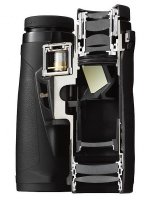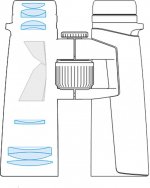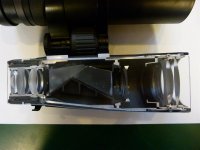OK, Dennis I'll go a little ways down the rabbit hole with you, but then I'm out and back to the adult world.
https://www.birdforum.net/images/smilies/cat.gif
First, we can't even speculate about how good the color correction of any 42mm triplet is without knowing it's focal ratio and glass types. A marketing claim that such a lens is a "true triplet Apochromatic lens system" should be met with plenty of skepticism until it's tested (and I don't mean tested by just looking through the binocular). Now, at the risk of a little pedantry let's back up and examine the quality of the information about the UHD objective lens that Vortex' actually gives us. Here it is:
"Apochromatic (APO) Lenses
"Rather than the more widely used and less expensive achromatic doublet lens design that as the name suggests uses two lens elements within each lens, Vortex Razor UHD binoculars have apochromatic lenses that are usually made up of at least 3 lens elements.Whist this additional piece of glass in each lens is certainly one of the contributors to the instrument being both heavier and longer than average, the advantage is that instead of just two, an APO lens is able to focus three wavelengths of light onto a single point and thus are able to better reduce chromatic and spherical aberrations for a higher definition image."
The first sentence starts off forgivably wrong by calling the conventional cemented doublet used in binoculars an "achromatic doublet lens". It's a doublet alright, but at an aperture of 42mm and a focal ratio somewhere below f/4 such a lens doesn't even meet the minimum standard for an achromatic lens. There's a simple formula to determine the lowest focal ratio a conventional doublet can have and still meet the minimum standard of red and blue blurs three times the diameter of a focused green airy disk. That's N = 0.122D where N is the minimum focal ratio and D is the aperture in millimeters. So a 42mm conventional doublet needs to be f/5.1 to meet the minimum standard, which itself is none too good.
Then we are told that UHD binoculars have "apochromatic lenses that are usually made up of at least 3 lens elements" . So are the UHD objectives triplets or just "usually, at least" triplets?
Then we are told that "an APO lens is able to focus 3 wavelengths of light onto a single point". Presumably they mean their "APO" lens is able to focus blue, green and red to a single point. After ignoring violet that would be essentially perfect visual correction of longitudinal chromatic aberration, a very high standard. But then the next phrase says "and thus are better able to reduce chromatic and spherical aberrations". So which standard is met; perfect longitudinal CA correction for visual purposes or the lower fuzzy standard of "better" reduction of longitudinal CA compared to a conventional f/4 doublet? The latter I can believe, the former is "usually, at least" marketing BS when it's applied to fast binocular objectives.
As for the burning question of whether there are more triplets or doublets being used in current roof prism binoculars with internal focusing lets just say that both types can be found at all price points. Each belongs to a different historical line. The fixed triplets with moving negative focusing lenses go back to the original Leica Tronovid BAs from about 1990 and the fixed doublets with moving positive focusing lenses trace back to the 50/56mm Swarovski SLCs from the early 1990s. At the moment, at least among high end roofs the fixed triplets with negative focusing lenses prevail, with only the Zeiss SF (and I think some Meoptas) using fixed doublets with positive focusing lenses. I'll be happy to leave the chore of tallying up the doublets and triplets in all the inexpensive knock-offs to Dennis.
I'm jumping out of the hole now.







